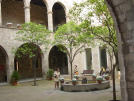ANTONI GAUDÍ
Antoni Gaudí i Cornet was born in Reus, on the 25th June 1852.
He completed architectural studies at the Escola Provincial d'Arquitectura
in Barcelona, from where he graduated in 1878. Before finishing his studies,
Gaudí collaborated with the architect Josep Fontserè on a
project for the Parc de la Ciutadella. In 1878 he won a contest to design
the street lights, still in existence today in the Plaça Reial of Barcelona.
Later, almost all his work was to have the city of Barcelona as its setting, with
the exception of the Villa El Capricho in Comillas (Santander), the Episcopal Palace
of Astorga (León), the Casa de los Botines in the city of León, and
just outside Barcelona, the crypt of the Colònia Güell, in Santa Coloma
de Cervelló by the Llobregat river. Between 1883 and 1926, Gaudí created
ten very diverse works: from private houses, schools, apartment buildings in the Eixample,
pavilions and an area planned as a garden city, to the unequalled splendour of the Sagrada
Família.
For further information:
Cátedra Gaudí
Av. Pedralbes, 7 (08034)
932 045 250
932 048 670
www.gaudi2002.bcn
www.sagradafamilia.org
www.gaudiclub.com
These are the ten works by Gaudí in Barcelona:
Casa Vicens (1883-1888)
Carolines, 18-24
Clearly oriental in inspiration, the use of colour in the ceramic tiles
of the façades of this building is remarkable, very different to
its setting in the Gràcia district of Barcelona.
Pabellones de la Finca Güell (1886-1889)
Av. de Pedralbes, 7
Two pavilions with a large wrought-iron gate which served as an entrance
to the old holiday estate belonging to the family of the financer Eusebi
Güell, Gaudí's great patron.
Palau Güell
(1886-1890)
Nou de la Rambla, 3
933 173 974 / 933 175 198
Built by Antoni Gaudí as the Barcelona residence of Count Güell,
its interior has extraordinary richness of detail.
Visits: Mon-Fri: 10-14/16-19.30h. Closed: Sat, Sun and holidays. Guided
tours in different languages.
Adults: 2,40 €.
Students and senior citizens: 1,20 €.
Col.legi de les Teresianes (1888-1890)
Ganduxer, 85-105
932 123 354
This building, built as a school, is imbued with an austerity and rationality
uncommon to Gaudí's works.
Visits by prior telephone: Mon-Fri: from 10h.
Sat (except July, August, September and holidays)
Casa Calvet (1898-1900)
Casp, 48
934 124 012
Although at first sight it does not look like one of the Gaudí's
works, one only has to enter the main-hall to see the details unique to
the architect.
Torre Bellesguard (1900-1904)
Bellesguard, 16
Built near the Serra de Collserola hills in the place where King Martí
l'Humà had his residence.
.
Park Güell (1900-1904)
Olot, s/n
934 243 809
This is the work of the greatest scope in terms of size which Gaudí
realized in Barcelona. It covers an area of 20 hectares, and the initial
aim was to make it a garden-city in the English style (the reason why
it was called a park). Gaudí collaborated with the architect Josep
Maria Jujol on this work. The park contains some architectural features
of unusual power: the two pavilions, linked by a stone wall, which mark
the main entrance from Olot street and the steps up to the park area;
the ceiling with 96 hypostyle columns supports the enormous square and
its curved benches, which looks over the plane of Barcelona; as well as
all those elements of the infrastructure such as the viaducts, holding
halls, raised walkways and numerous other unique components.
November-February: 10-18h.
May-August: 10-21h.
March and October: 10-19h.
April and September: 10-20h.
Parking for cars and coaches.
Guided tours: 1,20 €.
Casa Batlló (1904-1910)
Pg. de Gràcia, 43
934 880 666
934 883 090
Unique mosaic façade and ceramic roof.
Casa Milà,
La Pedrera (1906-1912)
Pg. de Gràcia, 92
Considered the epitome of Modernism with its impressive façade
of undulating stone and iron balconies. The irregular interior patios
and the startling roof designs are nothing less than fascinating.




